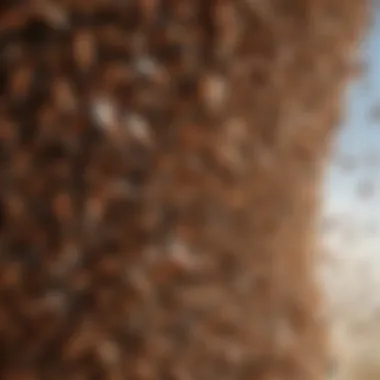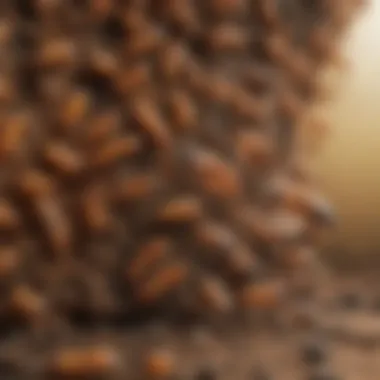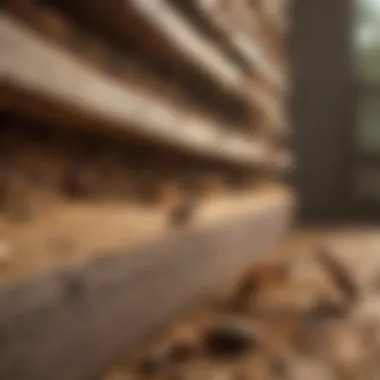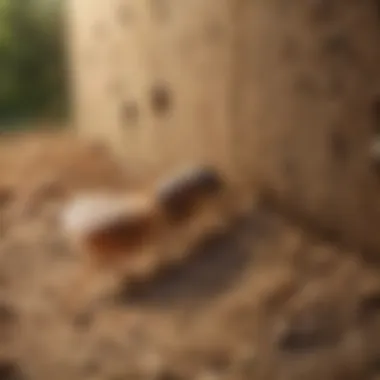Understanding Termite Swarming Behavior: Insights and Impacts


Intro
Termites are often unseen yet can cause significant damage to properties. Understanding termite swarming behavior holds great importance for homeowners and housewives alike. This behavior signifies a crucial phase in their life cycle, particularly concerning their reproduction and the expansion of the colony. Awareness of this phenomenon could prevent structural damages and offer insights into effective pest management strategies.
This article will explore the environmental triggers that lead to termite swarming, the life stages of termites, and their implications for people living in infested areas. Each section will aim to provide practical advice and deeper insights on how to respond and mitigate the risks associated with swarming.
Identification of Common Pests
Termites are not the only pests that homeowners need to be aware of. Understanding how to identify common pests helps inform better prevention and control strategies. Not every pest behaves the same, and knowing the distinctions can make a difference.
Description of Common Pests
There are various types of pests that can invade homes. Some of the most frequently encountered include:
- Termites
- Ants
- Cockroaches
- Rodents
Each of these pests exhibits unique behaviors that can lead to infestations. Termites, for instance, are known for their wood-destroying habits, often hidden from plain sight. Unlike other pests, their presence might only become evident during swarming.
Signs of Infestation
Detecting an infestation early is pivotal. Here are some signs to watch for:
- Wood damage: Hollow-sounding wood or wood that crumbles easily.
- Mud tubes: These structures indicate termites are tunneling towards food sources.
- Swarmers: Seeing winged termites indoors often marks the start of a reproductive cycle.
"Recognizing these signs can provide a significant advantage in controlling termite populations before they lead to extensive damage."
Prevention Techniques
Preventing termite swarming behavior and potential infestations starts with proactive measures. Homes should be maintained carefully to thwart these pests from finding a suitable habitat.
Home Maintenance Tips
- Regularly inspect crawl spaces, attics, and basements for signs of moisture or decay.
- Store wood away from soil and the home’s foundation.
- Ensure gutters and downspouts are clear to divert moisture away from the house.
Environmental Modifications
Creating barriers can deter termites from encroaching on your property. Consider these environmental modifications:
- Reduce wood-to-soil contact in landscaping.
- Fix leaks promptly to limit standing water near your home.
- Incorporate physical barriers like steel mesh during construction, which can mitigate future infestations.
Eco-Friendly Pest Control Options
For those leaning towards eco-friendly methods, several solutions exist that are effective yet gentle on the environment.
Natural Pesticides
Using natural pesticides can help minimize pest populations without harmful chemicals. Examples include orange oil and diatomaceous earth, which can target multiple pests, including termites.
Organic Pest Control Techniques
Implementing cultural practices can also aid in controlling pests organically. Composting and proper waste management promote a balanced ecosystem, potentially deterring pest presence naturally.
What Is Termite Swarming?
Termite swarming is an integral aspect of the termite life cycle, primarily associated with reproduction and the spread of these insects. Understanding this phenomenon is crucial for homeowners, especially in regions prone to termite infestations. The swarming behavior not only signifies the potential for a new colony establishment but also indicates a probable threat to structures. The significance of recognizing swarming can lead to timely interventions, safeguarding homes from infestations.
Definition of Swarming
Swarming refers to the event when winged reproductive termites, known as alates, leave their colonies to find mates and establish new colonies. This event often occurs in substantial numbers and is typically triggered by specific environmental conditions, such as humidity and temperature. The swarming process is usually a short-term event but can have long-lasting implications for homeowners who may find themselves in the path of approaching swarms.


The Lifecycle of Termites
To comprehend swarming behavior effectively, understanding the overall lifecycle of termites is essential. The lifecycle progresses through three main stages: egg, nymph, and adult. Each stage plays a vital role in the dynamics of termite colonies, influencing their reproductive success and population growth.
Egg Stage
The egg stage is the beginning of a termite's life, lasting a few weeks depending on factors such as species and environmental conditions. Termite eggs are small and oval-shaped, almost transparent in appearance, making them difficult to spot. Each female termite can lay hundreds to thousands of eggs. This prolific breeding is crucial for maintaining and expanding the colony, especially as swarming nears. However, the susceptibility of eggs to environmental factors can be a drawback, leading to high mortality rates if conditions are not favorable.
Nymph Stage
The nymph stage follows the egg phase and plays a crucial role in the colony’s development. Nymphs look similar to adults but lack wings. This stage can last a few months, during which nymphs undergo several molts to reach maturity. Nymphs contribute significantly to the colony as they develop into workers or soldiers, thereby enhancing colony efficiency. However, they require optimal conditions to thrive, which poses a risk within fluctuating environments.
Adult Stage
The adult stage is where termites exhibit their reproductive characteristics. Both male and female reproductive termites are referred to as alates. This stage is vital to the continuation of the species as adults participate in swarming events to mate. Once alates find partners, they will leave the colony to begin a new one. The adult stage is characterized by maturity and a significant increase in responsibilities, including colony defense and brood care. Yet, it is also the point where they are more vulnerable to predation and environmental stressors, impacting colony survival.
"Understanding the lifecycle phases helps homeowners recognize the signs of swarming and potential infestation, leading to prompt action."
Learning about termite swarming and their life stages provides valuable insights. Homeowners equipped with this knowledge can better prepare and protect their properties from potential damage.
Triggers for Termite Swarming
Understanding the triggers that initiate termite swarming is vital for homeowners. Recognizing these factors can help in taking preventive measures against potential infestations. The swarming behavior is not random. Instead, it is influenced by specific environmental and biological triggers that play a crucial role in termite life cycles.
Environmental Factors
Temperature Changes
Temperature is a prominent factor that influences termite swarming. When temperatures rise, often in late spring or early summer, termites become more active. They rely on certain temperature thresholds to signal their readiness to swarm. These temperature shifts serve as an important cue for their reproductive behavior.
A key characteristic of temperature changes is that it directly impacts their internal biological clocks. At optimal temperatures, alates (winged termites) emerge in large numbers. This phenomenon can be a significant cue for homeowners. Being aware of these changes can help them prepare for potential swarms. However, extreme fluctuations can lead to erratic swarming, which might complicate management strategies.
Humidity Levels
Humidity also plays a critical role in termite swarming. Swarms typically occur when humidity levels reach an adequate threshold. High humidity is essential for the survival of alates after they leave the nest. This moisture helps wings remain wet, which is necessary for flight.
The unique feature of humidity is that it creates a favorable environment for successful mating. This can lead to a larger population if the conditions are right. However, low humidity can lead to premature die-off of alates, reducing the scope of a swarm. Therefore, understanding humidity is beneficial for predicting swarming events.
Seasonal Patterns
Seasonal patterns largely determine when swarms will happen. Most termite species swarm in the spring and summer. The life cycle of termites is closely aligned with seasonal changes, thus swarming aligns with these seasonal cycles of warmth and moisture.
A noteworthy aspect of seasonal patterns is that they help synchronize swarming events across large areas. This synchronicity can improve the chances of successful mating as many alates are active at similar times. However, the disadvantage is that overlapping swarming seasons may lead to increased competition among colonies, affecting overall survival rates.
Biological Triggers
Colony Growth
Colony growth is a significant biological trigger. As termite colonies expand, they reach a threshold where reproductive swarming becomes necessary for sustainability. Larger colonies produce more alates, which are essential for reproduction.
This characteristic highlights colony strength and health. A robust colony will likely swarm when it reaches a specific size. Understanding this can help homeowners identify the potential for swarming based on observable signs of growth, such as increased wood damage or mud tubes nearby. However, rapid growth can lead to unforeseen infestations, making it a two-edged sword.
Genetic Factors
Genetic factors influence which termites develop into alates. Not every termite becomes a reproductively active member. Genetic predisposition within the colony drives the production of alates, which swarms under the right conditions. This leads to a higher chance of survival for the species.
A unique feature of genetic factors is that they can dictate the timing and size of swarms. Some colonies may produce more alates based on previous successful swarming events. Understanding genetic factors provides insight into controlling termite populations. Nonetheless, genetic variability can result in unpredictable outcomes, complicating management once swarming begins.
Recognizing the roles of these triggers is essential for effective pest control and management in any property.
The Role of Reproductive Termites


The significance of reproductive termites in the swarming process cannot be overstated. They serve as the primary mechanism for the continuation and expansion of termite populations. Through their specialized roles, these insects ensure that new colonies can be established, and genetic diversity is maintained. Understanding their behavior and functions helps homeowners recognize potential pest threats within their homes and surrounding properties.
Alates and Their Function
Alates are winged reproductive termites that emerge during the swarming events. Their primary function is to leave the parent colony in search of new locations to establish colonies. This aspect of their life cycle is crucial for growth and survival of termite species. Alates, when they swarm, are searching for mates. This search not only increases genetic variation but also serves in dispersing the population away from overcrowded areas.
Mating Behavior
Mating behavior of alates unfolds shortly after swarming. It involves both pair formation and flight patterns, which are critical for successful reproduction.
Pair Formation
Pair formation is a key process in the mating behavior of alates. After swarming, they often land, shed their wings, and seek out partners. This act of wing shedding is symbolic and signifies their transition into a reproductive role. The notable characteristic of pair formation is that it usually occurs soon after landing. This is beneficial as it facilitates quicker establishment of new colonies. However, the short duration for successful pairing means that some may fail to mate before desiccation or predation occurs.
Flight Patterns
Flight patterns are another important aspect of the mating process. Alates engage in synchronized flights, which help them to locate each other. Typically, they will fly in large groups during the peak swarming times, often influenced by weather conditions. The unique feature of their flight patterns involves detecting pheromone trails released by potential mates. This attraction often results in high-density mating events, which can lead to more successful fertilization. However, this high density can also attract predators, which poses risks to the newly formed pairs.
"Understanding the intricate behaviors of reproductive termites not only informs pest management strategies but also emphasizes the adaptive survival tactics of this species."
By delving into the role of reproductive termites, homeowners gain insights into the lifecycle of these pests. Recognizing the functions of alates and their mating behavior is vital. It enhances awareness of when to be vigilant about potential infestations. This knowledge can guide effective pest management decisions.
Swarming Behavior Patterns
The examination of swarming behavior patterns is vital to understanding the reproductive and survival strategies of termites. Swarming serves as a mechanism for dispersing reproductive individuals in search of new colonies. This section focuses on the timing of swarms and the formation of swarm clouds, entities crucial for homeowners to recognize the signs of termite activity and understand when and how to respond.
Timing of Swarms
Daytime Vs. Nighttime
Termites can swarm both during the day and at night, but the choice of timing has important implications. Swarming during the daytime allows termites to take advantage of warm sunlight, which helps in finding mates and establishing new colonies more effectively. The bright light may assist in visual navigation.
Conversely, nighttime swarming may offer some cover from predators, thus improving the survival rate of the alates. The darkness does not hinder their navigation but may affect their visibility and attraction to light sources. Still, many termites prefer night for their swarming activities.
The unique factors of daytime and nighttime swarming present advantages and disadvantages for homeowners. Detecting swarming terms in daylight, for example, may be easier for individuals who are vigilant.
"Understanding when termites swarm can significantly aid in early detection of infestations."
Peak Swarming Seasons
Peak swarming seasons typically occur during certain times of the year when conditions are optimal for reproduction. Environmental factors such as warmth and humidity drive these swarming events. A homeowner might observe significant swarming activities in spring or early summer when temperatures rise and moisture levels are ideal.
Understanding peak swarming seasons is essential for effective pest management. By being aware of these times, homeowners can enhance their preparedness against potential infestations. The unique feature of peak seasons lies in the synchronized swarm of numerous alates, increasing the chance of finding mates and establishing colonies.
However, these swarming seasons also signify a heightened risk of property damage should alates find their way into structures.
Formation of Swarm Clouds
The formation of swarm clouds involves the organized behavior of alates as they gather and take flight. This aspect of termite swarming is significant as it not only signals reproductive activity but also provides clues for homeowners. Observing the emergence of swarm clouds can alert individuals to potential infestations nearby.
Swarm clouds can be composed of thousands of alates, and their presence is often an indication of colony health and reproductive success. The capacity for these clouds to travel significant distances raises further awareness for property owners about their exposure to new infestations, should they live in proximity to established termite colonies.
Impact of Termite Swarming on Homeowners
Termite swarming behavior is not just a natural phenomenon; it carries significant implications for homeowners. Understanding this aspect is critical for effective pest management. When termites swarm, they are actively searching for new territories to establish colonies. This process can lead to potential infestations in homes, making it essential for property owners to be vigilant.
The presence of swarming termites indicates that a colony is thriving nearby. This can be alarming, as termites are known for their destructive capabilities. Homeowners should recognize that swarming is often a precursor to more significant problems if left unchecked. Awareness and knowledge are key advantages for those who want to protect their homes from these pests.
Signs of Swarming Activity


Wing Discard
One of the most noticeable signs of termite swarming is the presence of discarded wings. After alates, or reproductive termites, mate, they shed their wings. This wing discard is a critical indicator of significant swarming activity. Observing wings can help homeowners identify potential infestations early, which is beneficial for timely intervention.
The primary characteristic of these wings is their size and color. Termite wings are usually light brown to gray and have a translucent appearance. The presence of these wings around windows or doorways is a telltale signal that termites have been active in the area.
Realizing this sign is crucial since the time after swarming is when termites will start to search for new nesting sites, often within wooden structures in homes. Acting quickly can help mitigate future damage that could result from a full-blown infestation.
Presence of Alates
The term "Presence of Alates" refers to the swarmers themselves—the reproductive adults that take flight during swarming events. Spotting these alates is another significant sign for homeowners to monitor. Their presence can be alarming, as it suggests nearby colonies are seeking to expand.
Alates are key to the reproductive cycle of termites, and they are distinguishable by their elongated bodies and two sets of wings. Recognizing them is important for homeowners, as finding them indicates that a colony is nearby and may soon pose a threat to the structure of the house.
The unique feature about alates is that they only swarm at specific times, often during warm, humid weather in the evening. Knowing when to look for these swarmer can enhance a homeowner's awareness. If found in large numbers, this indicates high reproductive activity, raising the likelihood of property damage due to infestations.
Potential Property Damage
Once homeowners recognize the signs of swarming, they must consider the potential property damage that can follow if termites set up a colony nearby. Termites consume wood, which is their primary food source. Over time, even small infestations can lead to substantial damage.
The implications of termite damage can be severe, including weakened structures that may become dangerous. Homeowners should be proactive when faced with swarming to prevent termites from laying claim to their home. Regular inspections and prompt action when signs are detected will reduce the risks associated with these pests.
Ultimately, understanding the impact of termite swarming behavior allows homeowners to take decisive actions. By recognizing signs of swarming and understanding the threat of damage, property owners can better protect their investments.
Pest Management Strategies
Effective pest management strategies are crucial for protecting properties from potential termite infestations. Understanding these strategies helps homeowners minimize risks associated with termite swarming, which can lead to significant structural damage. This section discusses various methods for preventing and controlling termite swarms, ensuring homeowners are equipped with the knowledge needed to safeguard their homes.
Prevention Methods
Moisture Control
Moisture control is a fundamental aspect of preventing termite activity. Termites thrive in humid environments, making it essential for homeowners to reduce sources of excess moisture. By ensuring proper drainage, fixing leaky pipes, and utilizing dehumidifiers in basements and crawl spaces, moisture levels can be kept at bay. This proactive measure is beneficial because it directly addresses one of the primary factors attracting termites. Moreover, a key characteristic of moisture control is its simplicity; basic home maintenance can have a profound impact. However, this strategy requires continuous effort and monitoring.
Regular Inspections
Regular inspections are also a vital method for identifying early signs of termite activity. These inspections should occur at least once a year, or more frequently in areas prone to infestations. Homeowners can either carry out these inspections or hire professionals to assess the situation. A key characteristic of regular inspections is their preventive nature; early detection of potential issues can save time and money. The unique feature of this approach is that it creates an opportunity to identify conditions conducive to termite swarming before they become problematic. Nevertheless, regular inspections require diligence and commitment, acting as a safeguard against unforeseen damage.
Control Measures During Swarming
When swarming occurs, immediate control measures can help manage the situation effectively. Understanding how to respond during swarming is crucial in preventing potential infestations.
Chemical Treatments
Chemical treatments are one method to control termite populations, especially during swarming. These treatments involve applying pesticides that target termites directly. Chemical treatments are popular among homeowners due to their effectiveness in eradicating existing populations and preventing future infestations. One unique feature of these treatments is their versatility; they can be applied as sprays, foams, or baits, depending on the case. However, careful application is necessary to minimize risks to non-target organisms and the environment. In addition, homeowners should consider hiring professionals for the safe application of these products.
Physical Barriers
Physical barriers are another effective control measure during swarming. They involve creating a protective barrier around the home using materials designed to deter termites from entering. This strategy is beneficial because it provides a long-term solution that does not rely on chemicals, making it an eco-friendly option for those concerned about chemical exposure. A unique aspect of physical barriers is their durability; once installed, they require minimal maintenance. However, they may be more costly in terms of installation, and not all homes are suitable for this method.
By combining various pest management strategies, homeowners can create a robust defense against termite swarming and potential infestations.
Finale
In analyzing termite swarming behavior, several key considerations emerge. First, the significance of understanding this natural phenomenon cannot be overstated. The swarming phase represents a crucial part of a termite's lifecycle, directly correlating with their reproductive success and potential for colony expansion. Homeowners must grasp these concepts to better anticipate and address potential infestations.
Recap of Key Points
- Definition of Termite Swarming: It is the process by which winged reproductive termites, known as alates, leave their colonies to mate and establish new colonies.
- Triggers for Swarming: Environmental conditions such as temperature and humidity play a vital role. These factors can lead to swarming events primarily in specific seasons.
- Reproductive Role of Alates: Alates are essential for the continuation of termite species. Their successful mating results in new colonies, making the understanding of their behavior critical for pest management.
- Homeowner Impact: Termite swarming signifies potential property threat, as it often precedes infestations. Recognizing signs of swarm activity is essential for taking timely action.
- Effective Pest Management Strategies: Knowledge of swarming patterns allows homeowners to implement proactive measures such as moisture control and timely inspections.
Importance of Vigilance
The importance of vigilance cannot be overlooked. Monitoring for signs of swarming activity should be a continuous effort. Awareness of the right time to look for swarming termites aids in early detection and eventual prevention of colony establishment.
"A well-informed homeowner is the first line of defense against termite infestations. Recognizing the signs and understanding the implications of swarming can save significant costs and headaches in the long run."
By maintaining awareness throughout the year, homeowners can tackle the threat of termites head-on. A proactive approach ensures that suitable measures are in place when swarming tends to occur, thereby reducing the likelihood of a full-scale infestation. As the impact of termite behavior spreads beyond just pest management, fostering a deeper understanding of these issues serves not only to protect property but also to empower homeowners.







